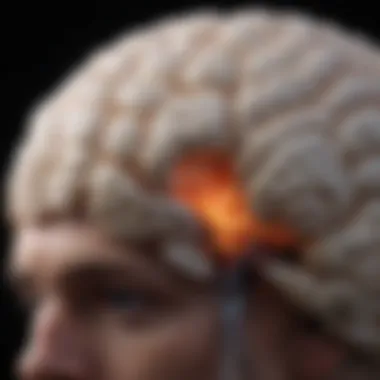Understanding Opiate Sickness: A Comprehensive Review


Intro
Opiate sickness represents a complex medical and social issue causing significant concern across various fields. For those affected, it often leads to debilitating physical and psychological symptoms. This article delves into the intricate layers of opiate sickness, emphasizing its multifaceted nature. By examining both physiological effects and societal implications, we gain a deeper understanding of the crisis that affects millions worldwide.
Article Overview
Purpose of the Article
This article aims to unpack the various elements of opiate sickness. From the mechanisms of opiate dependency and withdrawal symptoms to treatment advancements, a thorough exploration is essential. Understanding the implications not just for individuals but for society at large is paramount. By presenting recent research findings, we aim to illuminate pathways for effective treatment and policy challenges.
Relevance to Multiple Disciplines
The topic of opiate sickness is relevant across multiple disciplines including medicine, psychology, and public policy.
- In medicine, recognizing the physiological effects is crucial for developing effective treatments.
- Psychology offers insights into the behavioral patterns associated with opiate dependence.
- Public policy addresses the overarching frameworks governing drug use, prevention, and rehabilitation efforts.
This multifaceted relevance makes it a pressing matter that warrants closer investigation.
Research Background
Historical Context
The history of opiate use dates back centuries, recognized for its analgesic properties. However, it was not until the 20th century that concerns regarding dependency and withdrawal became prominent. The regulation of opiates accelerated due to alarming addiction rates and societal costs. The transition from medical usage to widespread abuse has shaped public perceptions and created a framework for contemporary discussions about opiate sickness.
Key Concepts and Definitions
To comprehensively understand opiate sickness, several key concepts should be defined:
- Opiate Dependency: A state resulting from compulsive use of opiates, characterized by physical and psychological reliance.
- Withdrawal Symptoms: A range of physical and mental effects experienced when an individual reduces or stops opiate use.
- Public Health Crisis: A widespread issue affecting community health, often linked to the over-prescription and misuse of opioids.
These definitions provide foundational knowledge essential for grasping the broader implications of opiate sickness in today's society.
"Addressing opiate sickness requires collaborative efforts across healthcare, policy, and local communities to create sustainable solutions."
"Addressing opiate sickness requires collaborative efforts across healthcare, policy, and local communities to create sustainable solutions."
Foreword to Opiate Sickness
Opiate sickness is a complex topic that holds significant importance in contemporary discussions surrounding public health and addiction. Understanding it requires a multifaceted approach, as it encompasses not just physiological dependency but also emotional and behavioral consequences that affect individuals and society at large.
In this section, we will cover critical aspects related to opiate sickness. We must explore its definition and historical context, shedding light on how perceptions and treatments have evolved over time. This lays the groundwork for understanding the intricate dynamics of opiate reliance, dependency, and their impacts. By focusing on these elements, we aim to provide a clear insight into why this topic remains relevant in ongoing healthcare discussions.
Definition and Context
Opiate sickness refers to a range of symptoms and conditions associated with opiate use, dependency, and withdrawal. Opiates are substances derived from the opium poppy or manufactured to mimic the effects of opium. These include drugs like morphine, codeine, and heroine. They bind to specific receptors in the brain, leading to pain relief and feelings of euphoria. However, regular use can result in profound changes to brain chemistry, which can, in turn, create a dependency.
In a broader context, opiate sickness often emerges during the transition from initial therapeutic use to problematic patterns of consumption. This is especially notable in the current climate of opioid prescriptions for pain management, which has, in part, driven the growth of addiction.
Historical Perspective
The history of opiate usage extends back thousands of years, with ancient cultures recognizing both the analgesic properties and the risks of addiction. The introduction of opiates for medicinal purposes marked significant developments in healthcare. However, it also laid the foundation for addiction challenges we face today. For instance, the nineteenth century saw the introduction of morphine as a pain relief agent, particularly for soldiers during the American Civil War. This increased the awareness of addiction, leading to the term “morphinism.”
In the 20th century, the development and marketing of synthetic opioids, alongside medications like OxyContin, contributed to the epidemic of opioid dependency seen in modern society. Therefore, to fully understand current opiate sickness, one must recognize this historical context that shaped the drug landscape, drug policies, and societal responses to addiction.
"The understanding of opiate sickness must encompass both the historical context and the ongoing societal implications of opiate dependency."
"The understanding of opiate sickness must encompass both the historical context and the ongoing societal implications of opiate dependency."
Overall, the introduction of opiate sickness must blend scientific inquiry with a thorough consideration of its societal ramifications. Understanding these factors equips professionals, educators, and researchers with the tools needed to tackle the ongoing challenges associated with opiate use.
Physiology of Opiates
The physiology of opiates is crucial to understanding their impact on both the individual and society. It connects the biological mechanisms with the effects of opiate use, including their potential for addiction and withdrawal. This section describes how opiates interact with the body, creating both therapeutic benefits and significant health risks.
Mechanisms of Action
Binding to Opioid Receptors
Binding to opioid receptors is a fundamental process in the action of opiates. These receptors are located in the brain and spinal cord and are integral in the modulation of pain and rewards. When opiates bind to these receptors, they inhibit the transmission of pain signals. This characteristic makes them widely used in pain management. Furthermore, the binding leads to a decrease in the perception of pain, which is beneficial for patients undergoing surgical procedures or enduring chronic pain.
However, this interaction has a dual nature. While it provides considerable relief, it also opens the door to tolerance and dependency. Prolonged usage can cause the receptors to become less responsive, requiring higher doses for the same effect. This aspect of binding to opioid receptors raises serious concerns regarding long-term use, as it sets the stage for addiction. In summary, while this mechanism is advantageous for therapeutic purposes, it requires careful monitoring to mitigate the risks of misuse.


Neurotransmitter Interactions
Neurotransmitter interactions play a critical role in how opiates exert their effects. Opiates influence various neurotransmitters, including dopamine, which is closely associated with pleasure and reward. When opiates stimulate the release of dopamine, they induce feelings of euphoria, further contributing to their addictive qualities. This unique feature of neurotransmitter interaction highlights the balance between therapeutic effects and the potential for abuse.
By boosting dopamine levels, opiates can create a reinforcing cycle of use, making it difficult for individuals to cease consumption. This allure underscores both their popularity as pain management solutions and their perilous nature concerning addiction. The challenge lies in managing these interactions effectively in clinical settings while also ensuring that patients are educated about the risks involved.
Effects on the Central Nervous System
Pain Relief and Euphoria
Pain relief and euphoria are central to the benefits associated with opiate use. Opiates effectively alleviate severe pain, making them indispensable in medical practice. This benefit is particularly evident in post-surgical care and terminal illness management. The capacity for pain relief underlies the rationale for prescribing these substances.
Nevertheless, the euphoric effects are a double-edged sword. While they can improve a patient's quality of life by reducing pain and improving mood, they also contribute to the potential for misuse. This makes opiate medications both widely valued and heavily scrutinized. Their appeal rests on their ability to provide quick relief, but varying responses from patients necessitate a tailored approach in clinical application.
Potential for Addiction
The potential for addiction is perhaps the most significant concern surrounding opiate use. It stems from their effects on the brain's reward system, where increased dopamine leads to reinforcement of opiate consumption. This characteristic creates a risk of dependency among users. Once a dependency develops, individuals often find themselves in a cycle of cravings, leading to increased intake and eventual withdrawal symptoms if they attempt to reduce usage.
This aspect raises vital questions about prescription practices and the ethical obligations of healthcare providers. Balancing the need for pain relief against the risk of addiction is a complex challenge in modern medicine.
"The opioid epidemic is a substantial public health challenge, illustrating the need for education on the risks associated with opiate use."
"The opioid epidemic is a substantial public health challenge, illustrating the need for education on the risks associated with opiate use."
Addressing these factors is integral to developing comprehensive treatment approaches and informing patients about the risks of opiate-related dependencies.
Opiate Dependency and Withdrawal
Opiate dependency and withdrawal are critical topics in understanding the complexities of opiate sickness. These aspects reveal how individuals become reliant on substances like morphine and oxycodone, leading to significant health crises. The implications of dependency extend beyond the individual, affecting families and communities. Understanding this dependency can inform better treatment methods and public health interventions, which ultimately aim to reduce the harmful effects associated with addiction.
Understanding Dependency
Dependency on opiates develops through repeated use. The body's natural response to these drugs includes chemical changes in the brain, altering its normal functions. Notably, opiates increase dopamine levels, which creates feelings of pleasure. This sensation can lead individuals to seek more of the substance, fostering a cycle of dependency. The risk of developing a dependency varies among individuals, influenced by genetic factors, mental health status, and social environment.
Individuals often find themselves in a situation where they need to consume larger doses to achieve the same effect, a phenomenon known as tolerance. This escalating need can be dangerous as it heightens the chances of overdose. It also creates a situation where a person may continue taking opiates despite negative consequences, indicating a mild or severe addiction.
Withdrawal Symptoms
Withdrawal occurs when a person reduces or stops using opiates after a prolonged period of dependency. The body, having adapted to the drug, struggles to function without it. Expectedly, withdrawal symptoms can vary widely among individuals, often appearing within hours after the last dose.
Physical Symptoms
Physical symptoms in withdrawal can range from mild discomfort to severe, debilitating challenges. Common experiences involves:
- Nausea and vomiting: Familiarly known to evoke pain during withdrawal.
- Muscle aches and cramps: A result of the body adjusting to the absence of opiates.
- Cold flashes and sweating: The body's temperature regulation can become erratic.
- Insomnia: Many individuals struggle to find restful sleep during this period.
These symptoms can be highly intense, often pushing individuals to seek relief through continued substance use. The significance of highlighting physical withdrawal is to educate on the very real pain and discomfort that many face. Understanding these symptoms can be crucial for both support systems and recovery methods.
Psychological Symptoms
Psychological symptoms during withdrawal can be equally challenging, often manifesting as:
- Anxiety: Heightened levels of unease often accompany the lack of opiates.
- Depression: A common response as the brain struggles to adjust.
- Irritability: Many individuals experience increased frustration during this time.
- Cravings: A powerful urge to consume opiates can emerge.
These psychological aspects of withdrawal significantly contribute to the overall struggle of recovery. They highlight the emotional toll dependency takes on individuals, making the need for comprehensive treatment even more pressing. By understanding these symptoms, healthcare providers and family members can create supportive environments to aid recovery.
"Opiate withdrawal is characterized by both physical and psychological discomforts, underscoring the complexity of recovery from addiction."
"Opiate withdrawal is characterized by both physical and psychological discomforts, underscoring the complexity of recovery from addiction."
Psychological Implications of Opiate Sickness
The psychological implications of opiate sickness are multifaceted and significant. Understanding these aspects is crucial for addressing the broader concern surrounding opiate dependency. Opiates can lead not only to physical dependency but also to various psychological challenges that may persist long after the drugs are eliminated from the body. Given that a large number of individuals who experience opiate sickness are also battling psychological distress, this connection warrants thorough examination.
Cognitive Effects
Cognitive effects associated with opiate use and withdrawal are complex. Users may experience impaired cognition, including issues with attention, memory, and decision-making. Research has shown that long-term opiate exposure can lead to alterations in brain function, particularly affecting areas responsible for higher-order thinking. Consequently, individuals may find it challenging to engage in productive tasks, maintain focus, and even recall information accurately.
Some common cognitive effects include:
- Memory lapses
- Decreased problem-solving abilities
- Diminished attention span


These cognitive challenges can significantly hinder a person's ability to function effectively in daily life. This decline in cognitive performance is not always temporary; in some cases, lingering effects may continue after cessation of drug use. Thus, addressing cognitive rehabilitation becomes a vital part of treatment.
Emotional and Behavioral Aspects
The emotional landscape of individuals suffering from opiate sickness is often tumultuous. Many experience heightened anxiety, depression, and mood swings. The interplay between these emotional disturbances and substance use creates a vicious cycle that further complicates recovery. Opiates can initially soothe emotional pain, leading individuals to rely on them for comfort. However, as dependency develops, the lack of the drug can exacerbate feelings of hopelessness and despair.
Behavioral aspects also play a critical role. Changes in behavior due to emotional distress include:
- Withdrawal from social situations
- Engagement in riskier behaviors
- Difficulty maintaining relationships
These behaviors can alienate affected individuals from their support networks, intensifying isolation and fueling further dependency. Recognizing the full scope of emotional and behavioral effects is essential for developing effective therapy strategies, including counseling and support group interventions.
Understanding the psychological implications of opiate sickness is vital for effective intervention and treatment. Without addressing the emotional and cognitive challenges faced, recovery efforts may falter.
Understanding the psychological implications of opiate sickness is vital for effective intervention and treatment. Without addressing the emotional and cognitive challenges faced, recovery efforts may falter.
Treatment Approaches
Treatment approaches to opiate sickness play a critical role in managing dependency and supporting recovery. These approaches can significantly enhance the chances of successful treatment outcomes. They often combine medical interventions with psychological support, addressing both the physiological and mental aspects of opiate addiction. Understanding these methods helps individuals, educators, and professionals grasp the complexity of treatment options available today.
Medication-Assisted Treatment
Medication-assisted treatment (MAT) integrates medications with counseling and behavioral therapies. This combination is effective in treating opioid dependence and alleviating withdrawal symptoms. It provides a well-rounded approach to recovery.
Suboxone
Suboxone is a medication that contains buprenorphine and naloxone. Buprenorphine is a partial opioid agonist, which means it activates opioid receptors in the brain but to a much lesser extent than full agonists like heroin or prescription opioids. The main aspect of Suboxone is its unique ability to minimize withdrawal symptoms while preventing misuse due to naloxone, which counters the effects if misused.
Key Characteristics of Suboxone:
- Partial Agonist: This limits the high that comes with full agonists.
- Decreased Risk of Overdose: The combination of buprenorphine and naloxone reduces the likelihood of misuse.
Suboxone is a popular choice due to its effectiveness in stabilizing opioid dependents. However, its unique feature also comes with disadvantages. Some may experience side effects such as headaches or nausea. Additionally, access to Suboxone treatment centers can be limited in some areas, making it less accessible for those in need.
Methadone
Methadone is another medication used in the treatment of opioid addiction. It is a long-acting full opioid agonist. Similar to Suboxone, Methadone helps alleviate withdrawal symptoms and cravings. Its use allows individuals to engage more effectively in recovery programs.
Key Characteristics of Methadone:
- Long Half-Life: It stays in the body for an extended period, allowing for less frequent dosing.
- Effective Craving Management: It mainly reduces cravings for other opioids, making it vital for many in treatment.
Methadone is a beneficial choice because it can be tailored to individual dosage needs, which helps maintain stability in recovery. However, Methadone does carry significant risks, including potential misuse and overdose. Individuals in treatment must be closely monitored to mitigate these risks.
Behavioral Therapies
Behavioral therapies are essential in addressing the psychological aspects of opiate addiction. These approaches focus on changing harmful behaviors and encouraging coping strategies.
Cognitive Behavioral Therapy
Cognitive Behavioral Therapy (CBT) is a psychological intervention that helps individuals recognize and change negative thought patterns. In the context of opiate addiction, CBT enables individuals to understand triggers for substance use and develop coping mechanisms. This therapy is vital for fostering resilience and supporting long-term recovery.
Key Characteristics of CBT:
- Focus on Coping Skills: It equips individuals with tools to manage stress and triggers that lead to relapse.
- Structured Sessions: Sessions are goal-oriented, offering a clear path towards recovery.
CBT is highly regarded due to its structured approach and flexibility in delivery, whether in individual or group settings. However, access to trained professionals can be a barrier for some individuals seeking this treatment.
Motivational Interviewing
Motivational Interviewing (MI) is a counseling approach that seeks to evoke intrinsic motivation for change. It is particularly beneficial for individuals who may feel ambivalent about treatment.
Key Characteristics of MI:
- Client-Centered: It focuses on the individual’s perspective and goals.
- Enhances Motivation: MI builds readiness for change, which can be vital for accepting treatment options.
Motivational Interviewing is significant in promoting engagement with treatment options. Its non-confrontational style can reduce resistance, allowing for a better therapeutic alliance. However, the effectiveness of MI can depend on the counselor’s skill in facilitating these discussions.
Societal Impacts of Opiate Epidemic
The opiate epidemic presents significant ramifications for society, affecting numerous aspects such as public health, economic stability, and social systems. Understanding these impacts is vital in addressing the crisis effectively and ensuring preventive measures are put in place. As more individuals are exposed to opiate dependency, there are cascading effects on families, communities, and healthcare systems.


Public Health Crisis
The public health crisis surrounding opiate addiction is alarming. With rising mortality rates due to overdoses, communities grapple with the pressures of inadequate resources for addiction treatment. The issue has escalated to the point where some regions declare public health emergencies. This crisis often translates to an increase in emergency room visits and a strain on healthcare resources.
Key factors include:
- Overdose deaths: The Centers for Disease Control and Prevention report that opioid overdoses account for a significant fraction of drug-related fatalities.
- Spread of infectious diseases: Increased sharing of needles leads to higher rates of infections like HIV and hepatitis.
- Mental health deterioration: The link between substance abuse and mental health issues complicates treatment and recovery.
Challenges associated with the public health crisis require comprehensive approaches that include preventive education and accessible treatment facilities to curb the epidemic's extensive consequences.
Policy Challenges
The policy landscape surrounding opiate management faces numerous challenges. Policymakers must navigate a delicate balance between ensuring adequate pain management for patients while preventing misuse and addiction. The developed regulations significantly influence both prescription practices and treatment access.
Regulation of Prescription Practices
The regulation of prescription practices is a critical factor in managing the opiate epidemic. Stricter guidelines aim to reduce unnecessary prescriptions while safeguarding patient rights to pain management. Key considerations include:
- Limitations on Prescription: New laws set tighter limits on the quantity and duration of prescriptions to combat over-prescription.
- Education for Healthcare Providers: Initiatives to educate healthcare professionals on responsible prescribing practices have emerged.
One of the main benefits of such regulations is the reduction of excess medication in the community, which lowers the likelihood of misuse. However, some argue that overly strict rules can hinder access for patients with legitimate pain needs, underscoring the need for balance in policy formulation.
Access to Treatment
Access to treatment remains a significant obstacle in fighting the opiate epidemic. Even with regulations in place, many individuals struggle to find appropriate care due to various factors, including:
- Availability of Treatment Centers: In many areas, there are insufficient treatment facilities to meet the demand.
- Financial Barriers: The cost of treatment can be prohibitive, restricting access for lower-income individuals.
The unique attribute of improving access to treatment involves creating more community resources and outreach programs aimed at assisting those seeking help. Enhanced accessibility can lead to better recovery outcomes, although it often requires significant investment and commitment from both public and private sectors.
Emerging Research and Developments
Emerging research in the context of opiate sickness plays a crucial role in evolving our understanding and response to this public health crisis. As the landscape of substance use and addiction changes, it is imperative to examine new treatment methodologies and technologies that can offer enhanced support for individuals grappling with opiate dependency. The ongoing developments in this field are aimed at improving outcomes for patients, minimizing the negative impacts of insufficiencies in existing practices, and achieving more effective, personalized care.
Innovative Treatment Methods
Innovative treatment methods represent a shift from traditional approaches towards more adaptive, evidence-based strategies. Research into novel pharmacological agents is particularly promising. For instance, compounds such as kratom have garnered attention as potential alternatives to conventional opiates. They may alleviate withdrawal symptoms while possessing a lower risk of addiction. Understanding these substances' mechanisms can help shape new clinical guidelines.
Additionally, the integration of behavioral therapies has shown considerable effectiveness. These methods include contingency management and mindfulness-based interventions. Each approach provides unique benefits, allowing for tailored treatments that resonate with diverse patient needs.
Role of Technology
The intersection of technology with healthcare has transformed how we approach treatment for opiate sickness. Technologies are not only improving accessibility but also enhancing the quality of care provided to these patients.
Telemedicine in Treatment
Telemedicine has emerged as a compelling solution to address barriers in accessing effective treatment for opiate dependency. This mode of healthcare delivery allows for remote consultations between patients and healthcare professionals, a vital feature during periods of high demand, such as the COVID-19 pandemic.
One key characteristic of telemedicine is its flexibility. Patients can engage with specialists without the need for traditional, in-person visits, which can be especially beneficial for those in rural areas or those with mobility issues. Importantly, telemedicine can decrease stigma for patients seeking help, fostering a more open dialogue about their struggles.
However, challenges do exist. Not all patients may be comfortable with technology, which can limit their engagement. Additionally, it is crucial to ensure the privacy of these online interactions. Yet, the benefits, such as increased treatment adherence and reduced dropout rates, make telemedicine an increasingly popular choice in the field of opiate treatment.
Data Analytics for Addiction Patterns
Data analytics plays a pivotal role in understanding addiction patterns, allowing clinicians and researchers to analyze trends and make informed decisions based on empirical evidence. By utilizing machine learning algorithms, healthcare providers can identify at-risk patients early on. This proactive approach enables targeted interventions that could prevent full-blown addiction from developing.
A key characteristic of data analytics in this context is its ability to analyze vast amounts of data quickly. Patterns that emerge from electronic health records and prescription histories can reveal insights into usage behaviors. This knowledge can further enhance patient care.
Nonetheless, challenges arise in implementing these technologies. Data privacy concerns and the potential for misuse of information are significant hurdles. Moreover, reliance on algorithms must be balanced with human insight to ensure comprehensive care. Despite these limitations, the prospect of utilizing data analytics to forge better understanding and intervention strategies remains a powerful tool in combating opiate sickness.
Culmination
The conclusion serves a pivotal role in encapsulating the multifaceted nature of opiate sickness as discussed throughout this article. It draws together key insights on the physiological, psychological, and societal implications of opiate use and dependency. The culmination of this exploration emphasizes not only the extensive impacts of opiate sickness on individuals but also its broader ramifications on public health and policy.
Focusing on summary of key points provides a vital opportunity to reflect on the findings presented. This creates a clear understanding for the readers about how deeply opiate usage can affect various facets of life. The discussion on emerging research illustrates the continuous evolution of treatment modalities and highlights the urgent need for innovative solutions in addressing this crisis. Moreover, considering the future directions of research and treatment offers a hopeful outlook, encouraging ongoing engagement with the complexities of addiction.
This conclusion reinforces the urgency of tackling opiate sickness, making it clear that both individual and collective actions are necessary. The challenges faced are profound and require a comprehensive strategy that includes education, policy reform, and access to treatment.
Summary of Key Points
- Opiate sickness encompasses not only physical withdrawal symptoms but also significant psychological effects.
- Treatment options like medication-assisted treatment (Suboxone, Methadone) combined with behavioral therapies have shown promise in alleviating dependency.
- The societal impacts of the opiate epidemic are profound, affecting public health systems and raising policy concerns regarding prescription practices.
- Innovative methods, such as telemedicine and data analytics, are emerging as essential tools in addiction treatment and prevention strategies.
- Ongoing research is critical for developing effective interventions that can adapt to the evolving challenges presented by opiate addiction.
Future Directions
Future directions in the context of opiate sickness should emphasize several important areas:
- Enhanced Research Efforts: There is a need for continued research into the neurobiological aspects of addiction and recovery processes. This could yield insights that lead to better-targeted therapies.
- Integrated Treatment Models: Combining pharmacological treatments with psychological support can improve recovery outcomes for those suffering from opiate addiction.
- Policy Reformation: Advocacy for policy changes that promote safe prescription practices, accessibility to treatment, and measures aimed at reducing stigma surrounding addiction can play a crucial role in managing the crisis.
- Public Awareness Campaigns: Increasing public awareness about the implications of opiate use, particularly for youth and vulnerable populations, can contribute to prevention efforts.
- Technological Innovations: Leveraging technology, such as mobile health applications and telehealth solutions, can enhance access to care and support, helping those in recovery stay connected.
By prioritizing these aspects in future initiatives, stakeholders can contribute significantly to addressing the ongoing challenge of opiate sickness in society.



